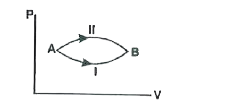A system goes from A to B via two processes I and II as shown in Fig. If ΔU1andΔU2 are the changes in internal energies in the processes I and II respectively, then :
 Solution in Kannada
Solution in Kannada
ΔU2<ΔU1
ΔU2>ΔU1
relation between ΔU1andΔU2 cannot be determined
ΔU1=ΔU2
The correct Answer is:D
ΔU is a state function. So, ΔU1andΔU2 depend only upon initial and final positions.
∴ΔU1=ΔU2
∴ Correct choice is (d).
Topper's Solved these Questions
- HEAT AND THERMODYNAMICSBOOK - MODERN PUBLICATIONCHAPTER - HEAT AND THERMODYNAMICSEXERCISE - Multiple Choice Questions (LEVEL-II)
55 Videos
- HEAT AND THERMODYNAMICSBOOK - MODERN PUBLICATIONCHAPTER - HEAT AND THERMODYNAMICSEXERCISE - Multiple Choice Questions (Level - III) (Questions From AIEEE/JEE Examination)
17 Videos
- GRAVITATIONBOOK - MODERN PUBLICATIONCHAPTER - GRAVITATIONEXERCISE - Recent Competitive Questions
8 Videos
- LAWS OF MOTIONBOOK - MODERN PUBLICATIONCHAPTER - LAWS OF MOTIONEXERCISE - Revision test
43 Videos
Similar Questions
The P-V diagram for a cyclic process is a triangle ABC drawn in order. The co-ordinates of A, B, C are (4,1), (2,4) & (2,1). The co-ordinates are in order of P- V in which P is in N/m2 & volume in litres. The work done during the process from A to B is:
View SolutionA thermally insulated vessel contains an ideal gas of molecular mass M and ratio of specific heats γ. It is moving with speed v and it is suddenly brought to rest. Assuming no heat is lost to the surroundings, its temperature increases by:
View SolutionAn astronaut on a strange planet finds that acceleration due to gravity is twice as that on the surface of earth. Which of the following could explain thin ?
View SolutionWhen a carpet is beaten with a stick, dust comes out of it. Explain.
View SolutionFollowing figure shows two process A and B for a gas. If ΔQA and ΔQB are the amount of heat absorbed by the system in two case, and ΔUA and ΔUB are changes in internal energies, respectively, then :

View SolutionA system goes from A and B via two processes. I and II as shown in figure. If DeltaU_1 and DeltaU_2 are the changes in internal enregies in the processes I and II respectively, then
View SolutionLet Delta U_(1) and Delta U_(2) be the changes in internal energy of an ideal gas in the processes A and B then
View SolutionThe internal energy of a system is U_(1) . In a process, work done by the system is W and heat accepted by the system is Q. At the end of the process, the internal energy of the system is
View SolutionA system can go from state A to state B in two different processes 1 and 2. If the change in internal energy in two cases are Delta U_(1) and Delta U_(2) , respectively, then
View Solutionदिये गये चित्र में दो प्रक्रियाओं A व B को एक गैस के लिये दिखाया है। यदि ΔQA व ΔQB इन प्रक्रियाओं के दौरान शोषित ऊष्माएँ तथा ΔUA व ΔUB गैस की आंतरिक ऊर्जा के परिवर्तन हैं, तो

View Solutionकिसी गैस की अवस्था A से B तक चित्रानुसार प्रक्रम I तथा II के अनुसार परिवर्तित होती है तो आन्तरिक ऊर्जा में परिवर्तन क्रमशः ΔU1 तथा ΔU2 है तब

View SolutionFor a diatomic gas change in internal energy for unit change in temperature for constant pressure and constant volume is ΔU1 and ΔU2 respectively. The ratio of ΔU1:ΔU2 is
View SolutionA gas is expanded from volume V0 to 2V0 under three different processes, as shown in the figure. Process 1 is isobaric process, process 2 is isothermal and process 3 is adiabatic. Let ΔU1,ΔU2 and ΔU3 be the change in internal energy of the gas in these three processes. Then

View SolutionAn ideal gas goes from state A to state B via three different processes as indicated in the P-V diagram. If Q_(1), Q_(2), Q_(3) indicate the heat absorbed by the gas along the three processes and Delta U_(1) , Delta U_(2), Delta U_(3) indicate the change in internal energy along the three processes respectively, then
View SolutionFollowing figure shows two process A and B for a gas. If ΔQA and ΔQB are the amount of heat absorbed by the system in two case, and ΔUA and ΔUB are changes in internal energies, respectively, then :

View SolutionA system goes from state A to B via two processes I and II, as shown in Fig. 12.25, How are delta mu_1 and delta mu_2 (the changes in internal energies in the processes I and II) related to each other ?
View Solution
